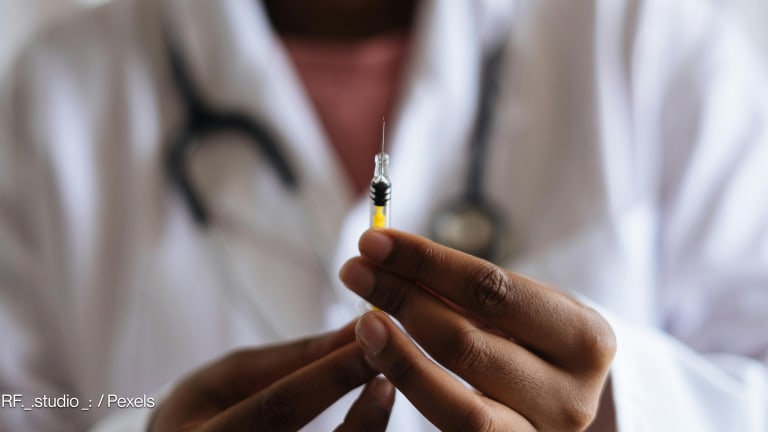Drones for good: Advice for donors, operators, and governments
Donors and their NGO partners are sharing experiences with unmanned aerial systems to learn from mistakes and build on successes. Here's what several top experts want to see next.
SAN FRANCISCO — PATH, a nonprofit global health organization, wanted to test the use of unmanned aerial systems, or UAS, in Senegal. The plan was to determine whether drones could deliver medical supplies between regular stock deliveries, as well as urgently needed supplies such as blood, and retrieve lab samples, said Joanie Robertson, a senior program officer leading PATH’s work on drone technology for health supply chains. But the drone manufacturer the donor selected for the project was not able to demonstrate the technical feasibility of the drone to the regulatory agency, so PATH was not able to move forward with the project. Donors and their NGO partners are increasingly sharing stories like this so they can learn from mistakes and build on successes. The Interagency Supply Chain Group, which brings donor agencies together to coordinate their work to improve global health supply chains, recently launched a UAS working group to provide one outlet for these conversations. But most of the focus in UAS still tends to be on the flashy technology rather than the enabling environment that will allow for “drones for good” to take flight. Devex spoke with UAS experts about their advice for donors, operators, regulators, and others who are exploring ways drones might meaningfully advance their work in global health, international development, and humanitarian response. Donors Sonja Betschart, co-founder of WeRobotics — which aims to bring the power of local to robotics through its network of Flying Labs — said one of the key differences between mapping drones and cargo drones has to do with donor involvement. For mapping drones, commercial investments are fully need-driven, whereas for cargo drones, donor investments are impact driven, she said. That creates different evaluation metrics for cargo drones, which focus more on demonstration and storytelling rather than actual market needs, Betschart said. Donor investments leave less opportunity for prototyping, or trial and error, which is what innovation is always about, she added. “One of the outcomes of this situation is that we rarely openly hear about the ‘failures’ in the cargo drone space, leaving actors to focus on the ‘wins,’” she said. While the commercial space is more open to the “fail and learn” approach, it does not tend to publicize its failure, instead, using this information internally to design better products and services. But donors should take a different approach: sharing their learnings of what does and does not work, for the good of the sector, Betschart said. Donors at IASG are doing this exercise, for example by exploring how drones can fit into a holistic supply chain system redesign rather than replace health supply chains. Sara de la Rosa, who manages conversations across many time zones as IASG’s point of contact for all activities related to UAS, outlined how a project might occur in three phases. Phase 1: proof of concept demonstrating the technology, phase 2: delivery service to collect evidence of health or other program indicators, and phase 3: scale to other regions within the country or across programs, she said. Donors should ensure there is government will, not only from the leading ministry, such as the ministry of health, but also from the regulators, such as the Civil Aviation Authority, and in some cases other branches of government, such as the military, de la Rosa added. Having a partner in-country to implement the project while also managing relations with government, industry, and other stakeholders, is also very important, emphasized de la Rosa. Operators Zipline, the only example of cargo drone delivery at a national scale, offers a full logistics solution including drones, technology, fulfillment, logistics, and delivery. But many drone companies only sell drone technology, which leaves donors and NGOs to figure out who will operate the aircraft. Scott Dubin, warehousing and distribution team lead at Chemonics, told Devex that a major challenge in this space is that donors and NGOs end up asking drone providers to become service providers. Part of the solution may be the work WeRobotics is doing to support a network of Flying Labs — a network of local drone experts around the world. But when donors and NGOs do bring in operators from the outside, local partnerships are key. When Devex asked what advice de la Rosa had for drone companies, she said: “Always bring more spare parts than you expect and an extra aircraft, and some engineering-skilled personnel to account for any unforeseen technical challenges.” She also advised operators to find or form partnerships with others who are locally based, so that services such as maintenance and repairs are available locally: “Remain transparent with the end client and reporting to donors as well as Civil Aviation Authority,” de la Rosa added. She advised NGOs working on drone projects in LMICs to undertake extensive community outreach, to explain the good that UAS can provide, and to minimize any public misperceptions about drone use. A handover plan for local partners is important, stressed de la Rosa. There should be a risk mitigation plan, clear procedures, and failsafe features, as well as a response and recovery plan in the event of a crash, she said. Governments Leslie Cary, head of the unmanned aircraft program at the International Civil Aviation Authority, said she is concerned about the ways that donors, U.N. agencies, NGOs, and others are working directly with governments to develop new regulations. But she did point to Vanuatu as one example of how governments can partner with the international development industry on drones for good. UNICEF brought in UAS consultants who worked with the Civil Aviation Authority Vanuatu, advising the authority to write regulations that would protect airspace while also allowing for more use cases beyond the delivery of vaccines. Meanwhile, IASG wants to see more regulators considering a performance-based assessment and approval process for incoming requests that offer clear societal benefits in humanitarian and international development contexts, de la Rosa said. If one government ministry is interested in UAS, it should reach out to other divisions, to see whether other ministries might also have an interest in UAS or could potentially cofinance aircraft services, she added. While the ministry of health is a key partner in drones for medical delivery, other ministries that might be interested in UAS include culture, transport, economy, and national emergency response, to name a few. Before they take on a project, the government should perform a needs assessment to collect baseline data and define the problem they aim to solve as well as the use case requirements and goals, de la Rosa said. Robertson of PATH said she wants to see donors and NGOs put more energy into figuring out the operating costs of including drones in health supply systems and address issues around government willingness to pay. Governments should “demand more information about the real costs and complexity of including drone delivery in the health supply chain ecosystem, and work to understand where the bang may be worth the buck,” she said. And she said operators should stay in touch with groups that bring players across sectors together, such as the UAV for Payload Delivery Working Group, and look out for upcoming guidelines from ICAO in order to align with best practices and emerging regulations as much as possible.
SAN FRANCISCO — PATH, a nonprofit global health organization, wanted to test the use of unmanned aerial systems, or UAS, in Senegal.
The plan was to determine whether drones could deliver medical supplies between regular stock deliveries, as well as urgently needed supplies such as blood, and retrieve lab samples, said Joanie Robertson, a senior program officer leading PATH’s work on drone technology for health supply chains.
But the drone manufacturer the donor selected for the project was not able to demonstrate the technical feasibility of the drone to the regulatory agency, so PATH was not able to move forward with the project.
This story is forDevex Promembers
Unlock this story now with a 15-day free trial of Devex Pro.
With a Devex Pro subscription you'll get access to deeper analysis and exclusive insights from our reporters and analysts.
Start my free trialRequest a group subscription Printing articles to share with others is a breach of our terms and conditions and copyright policy. Please use the sharing options on the left side of the article. Devex Pro members may share up to 10 articles per month using the Pro share tool ( ).
Catherine Cheney is the Senior Editor for Special Coverage at Devex. She leads the editorial vision of Devex’s news events and editorial coverage of key moments on the global development calendar. Catherine joined Devex as a reporter, focusing on technology and innovation in making progress on the Sustainable Development Goals. Prior to joining Devex, Catherine earned her bachelor’s and master’s degrees from Yale University, and worked as a web producer for POLITICO, a reporter for World Politics Review, and special projects editor at NationSwell. She has reported domestically and internationally for outlets including The Atlantic and the Washington Post. Catherine also works for the Solutions Journalism Network, a non profit organization that supports journalists and news organizations to report on responses to problems.








